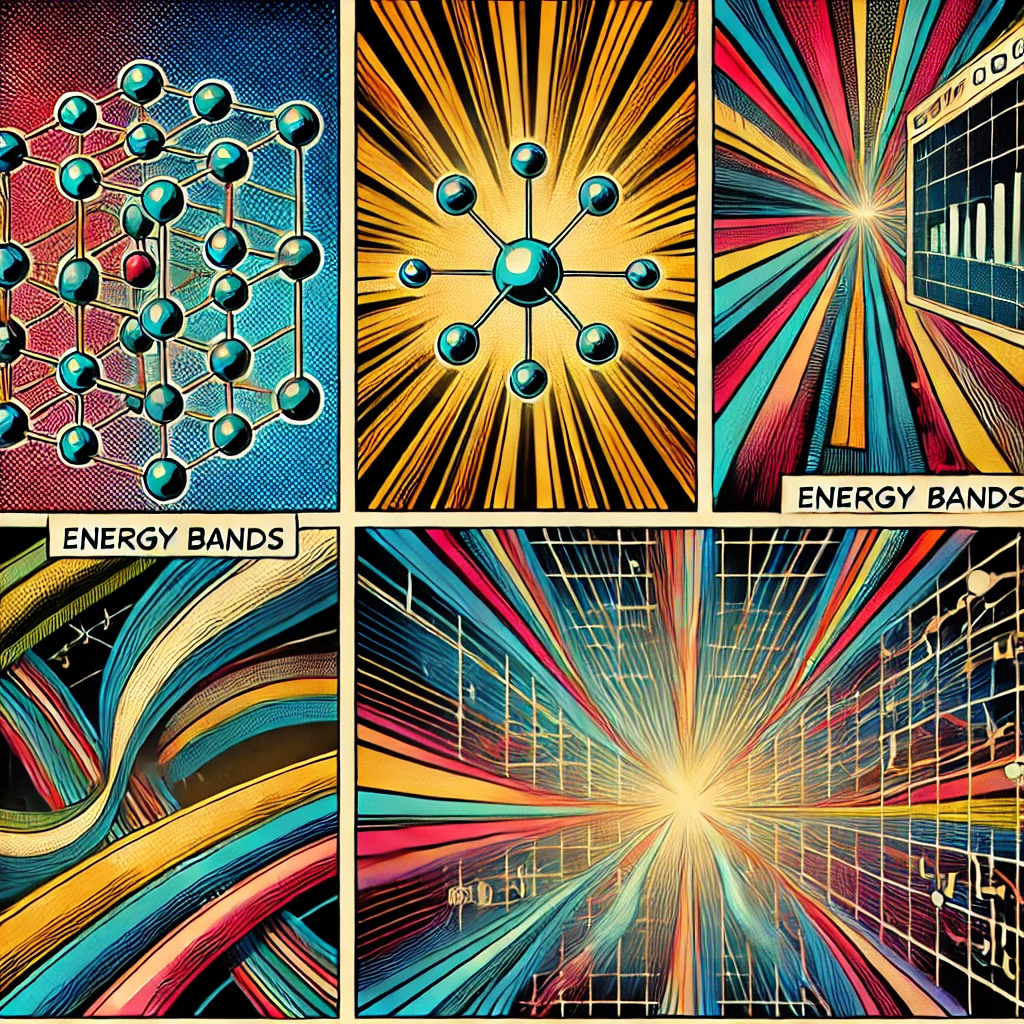Electron Movement through Solids Energy Bands and Semiconductors
Possibly Howard Dumble was correct.
Materials vary greatly in their ability to conduct electron flow. A digitalization may take place that has bearing on sound quality and overall performance, fidelity and response.
Electron movement through solids is a fundamental concept in condensed matter physics and semiconductor technology. In a solid material, such as a metal, semiconductor, or insulator, electrons are confined to the crystal lattice structure and exhibit behavior distinct from that in free space.
One of the key concepts used to describe electron movement in solids is the concept of energy bands. In a solid material, the allowed energy levels for electrons form continuous bands rather than discrete energy levels as in isolated atoms. These energy bands arise due to the periodic potential of the crystal lattice, which causes the energy levels of neighboring atoms to split and overlap, forming bands of allowed energy states.
The most important energy bands in solid-state physics are the valence band and the conduction band:
1. Valence Band: The valence band is the highest energy band filled with electrons at absolute zero temperature. Electrons in the valence band are tightly bound to the atomic nuclei and are not free to move under normal conditions.
2. Conduction Band: The conduction band is the next higher energy band, which is empty or only partially filled with electrons at absolute zero temperature. Electrons in the conduction band have enough energy to move freely throughout the material and contribute to electrical conduction.
The energy gap between the valence band and the conduction band, called the band gap, determines the electrical properties of the material:
– Insulators: Materials with a large band gap have a completely filled valence band and an empty conduction band at absolute zero temperature, making them insulators. In insulators, electrons require a significant amount of energy to transition from the valence band to the conduction band and contribute to electrical conduction.
– Semiconductors: Semiconductors have a smaller band gap compared to insulators, allowing electrons to transition from the valence band to the conduction band more easily, typically at finite temperatures. Semiconductors can be intrinsic, where the electron concentration is determined solely by the properties of the material, or extrinsic, where impurities are intentionally added to modify the conductivity.
– Metals: Metals have overlapping valence and conduction bands, allowing electrons to move freely throughout the material. Metals are good conductors of electricity due to the large number of free electrons available for conduction.
Understanding electron movement through solids and the concept of energy bands is essential for the design and optimization of electronic devices, such as transistors, diodes, and integrated circuits, which form the basis of modern semiconductor technology.
The movement of electrons through solids, particularly in the context of semiconductors, is governed by principles of quantum mechanics and band theory. In solid-state physics, band theory describes the behavior of electrons in a crystalline lattice, such as those found in semiconductors.
Here’s an overview of electron movement through solids and the concept of energy bands in semiconductors:
1. Energy Bands: In a crystalline solid, such as a semiconductor, the arrangement of atoms creates a periodic potential energy landscape for electrons. According to quantum mechanics, electrons in solids do not occupy discrete energy levels like they do in isolated atoms. Instead, the energy levels form continuous bands. The bands are separated by energy gaps known as band gaps.
2. Valence Band and Conduction Band: The two most important bands for understanding the behavior of electrons in solids are the valence band and the conduction band. The valence band is the band containing the highest-energy occupied electron states at absolute zero temperature. Electrons in the valence band are tightly bound to the atoms of the solid. The conduction band, on the other hand, is the band immediately above the valence band, and it contains empty or partially filled electron states. Electrons in the conduction band are free to move through the solid and contribute to electrical conductivity.
3. Band Gap: The energy gap between the valence band and the conduction band is known as the band gap. In insulators, this gap is large, and electrons require a significant amount of energy to move from the valence band to the conduction band. In conductors, the valence and conduction bands overlap, allowing electrons to move freely. In semiconductors, the band gap is relatively small, allowing electrons to be promoted from the valence band to the conduction band at moderate temperatures or with the application of external energy (e.g., heat or light).
4. Electron Movement in Semiconductors: In semiconductors, electrons can move through the crystal lattice by hopping from one atom to another. When an external voltage is applied to a semiconductor device, such as a diode or transistor, electrons can be pushed from the valence band into the conduction band, creating an electric current. The mobility of electrons in semiconductors depends on various factors, including the material properties, temperature, and presence of impurities.
Understanding the behavior of electrons in solids and the principles of energy bands is essential for the design and engineering of semiconductor devices used in modern electronics, including transistors, diodes, and integrated circuits.

https://soundquality.org/?s=dumble